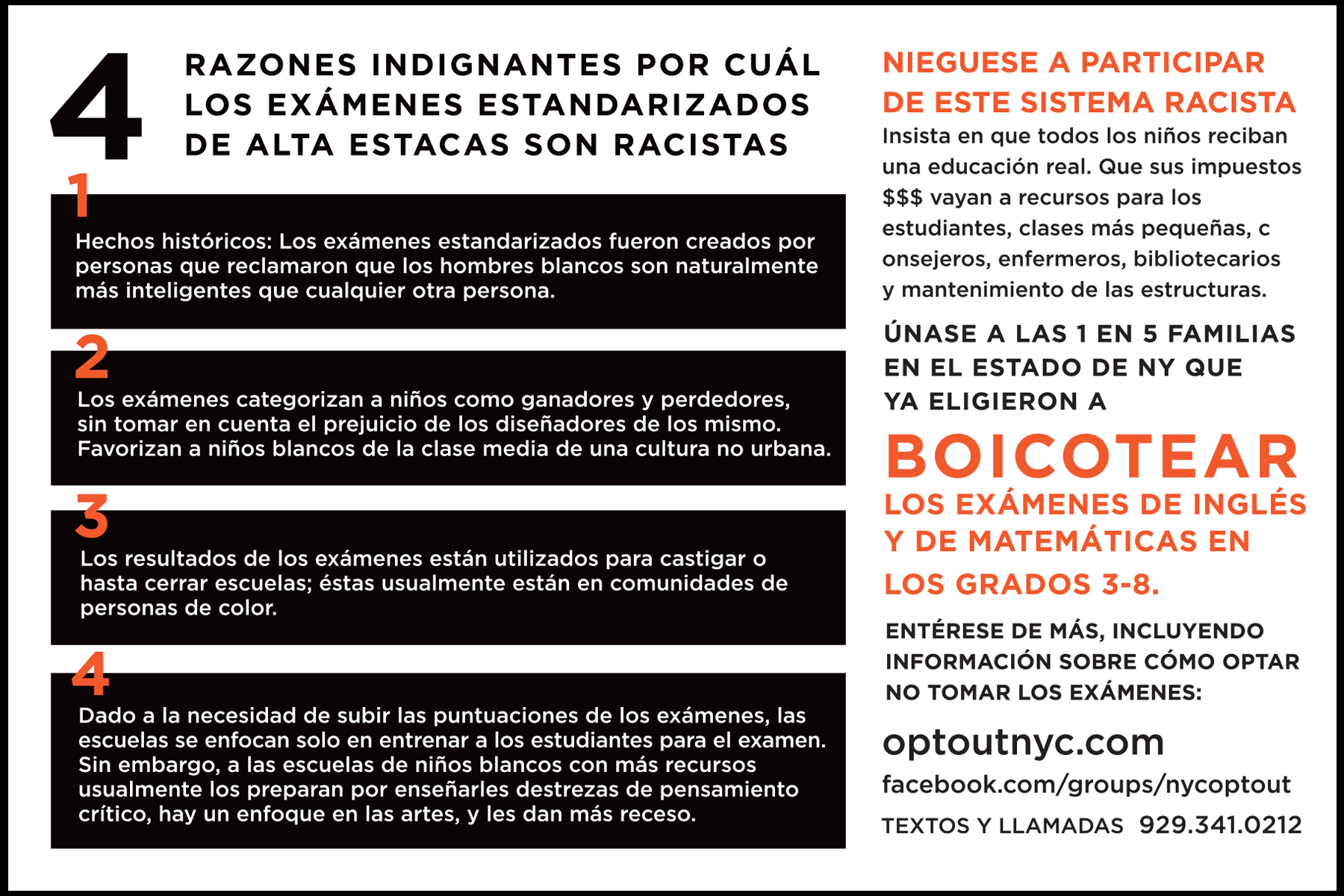Postcards
Are parents in your community aware that they have a right to refuse the tests? Do they know the racist underpinnings of the exams? Get that information to them! NYC Opt Out has two postcards designed to drive curious parents to our website and Facebook page, where they can find more information about test refusal in NYC. Share the images below on social media or CONTACT US if you would like a stack of printed cards to share in your community or at an event. In your request please specify which card(s) and quantity desired.
Your Child Can Too! Design by Ilana Greenberg
Are the NYS Math + ELA Tests Racist? Design by Ilana Greenberg
Sources:
Elsewhere on this website we link to articles and videos that interrogate the conjunction of race, class, and and standardized testing. (see A Deeper Dive: Testing, Race, & Class) Here we cite evidence for the specific claims made on our postcard.
1. HISTORICAL FACT:
Standardized testing was invented by people who claimed that white males were naturally smarter than others.
"An avowed eugenicist, [Lewis] Terman introduced and defended the viability of the nation’s first popular standardized intelligence test in his 1916 book, The Measurement of Intelligence. These “experimental” tests will show “enormously significant racial differences in general intelligence, differences which cannot be wiped out by any scheme of mental culture,” Terman maintained. He imagined a permanent academic achievement gap, a permanent racial hierarchy.
Terman’s IQ test was first administered on a major scale to 1.7 million U.S. soldiers during World War I. Princeton University psychologist Carl C. Brigham presented the test results as evidence of genetic racial hierarchy in A Study of American Intelligence, published three years before he created the SAT test in 1926.
Famed physicist William Shockley and educational psychologist Arthur Jensen carried these eugenic ideas into the 1960s. But by then, these genetic explanations—not the tests and the achievement gap itself—had largely been discredited. In other words, the construction of a permanent racial hierarchy had been replaced by the construction of a temporary racial hierarchy. (source)
2. The tests sort children into winners and losers, failing to take into account the biases of the test designers toward white, middle class, non-urban culture.
Standardized testing and school segregation: like tinder for fire? "Based on the evidence we argue that the intrinsic features of high-stakes testing, combined with current systems of school choice, function as mechanisms used for racial coding that facilitate segregation and compound inequalities found in schools." (source)
3. Test scores are used to punish or even close school, usually schools that serve mostly black and brown students.
The NYC DOE uses the following guidelines to identify struggling schools:
Were Identified as Priority or Focus Schools by the State Department of Education
- Priority: The bottom 5% lowest-performing schools statewide
- Focus: The bottom 10% of progress in a subgroup
Demonstrated low academic achievement for each of the three prior years (2012-2014):
- Elementary and middle schools in the bottom 25% in Math and ELA scores
- High schools in the bottom 25% in four-year graduation rate
- Scored “Proficient” or below on their most recent quality review
Scored “Proficient” or below on their most recent quality review
- Building on the Chancellor’s vision, the NYCDOE is looking beyond test scores to determine where schools need to improve.
This recent New York Times article provides information about current school closures.
4. Due to pressure to raise scores, students in these schools get served endless test prep, while students in whiter, richer schools are more likely to get creative problem solving, arts, and recess.
Research shows that high-stakes testing narrows the curriculum:
"Five years into NCLB, researchers found that 62 percent of a nationally representative sample of all districts in the United States—and 75 percent of districts with at least one school identified as needing improvement—increased the amount of time spent on language arts and math in elementary schools. These increases were substantial: a 47 percent increase in language arts and a 37 percent increase in math. Correspondingly, these districts decreased time allotted to other subjects and activities, including science, social studies, art, music, physical education, and recess (McMurrer, 2007).
Other studies from the NCLB era conclude that the higher the stakes are for educators, the more curriculum and instruction reflect what's on the test—particularly in low-performing schools where the threat of sanctions is strongest. A study of a large urban district from 2001 to 2005 (Valli & Buese, 2007) found that as worries about adequate yearly progress increased, teachers matched the content and format of what they taught to the state test. These researchers concluded that the content of the tests had effectively become the learning goals for students.
Au's 2007 synthesis of 49 recent studies found a strong relationship between high-stakes testing and changes in curriculum and pedagogy. More than 80 percent of the studies in the review found changes in curriculum content and increases in teacher-centered instruction. Similarly, a study of California, Georgia, and Pennsylvania school districts found that teachers narrowed their curriculum and instruction to focus on tested topics and also increased their use of test-like problem styles and formats (Hamilton et al., 2007).
NEA TODAY (News and Features from the National Education Association) published A The Testing Obsession and the Disappearing Curriculum in 2014:
"Not that long ago, elementary schools were places where students could discover what they were good at, explore the subjects that appealed to them, or maybe just be content with enjoying school.
But for many elementary school teachers who joined the profession during the last decade, and especially those who work in high-poverty schools, classrooms that provide vigorous learning opportunities to all students never existed—thanks, in large part, to the No Child Left Behind Act (NCLB).
Today, more than a decade later, the law is uniformly blamed for stripping curriculum opportunities, including art, music, physical education and more, and imposing a brutal testing regime that has forced educators to focus their time and energy on preparing for tests in a narrow range of subjects: namely, English/language arts and math. For students in low-income communities, the impact has been devastating."
A Policy Research Brief produced by the National Council of Teachers of English, How Standardized Tests Shape — And Limit — Student Learning (2014) found the following:
"The term standardized tests is often heard along with high-stakes. Standardized tests are administered, scored, and interpreted in a consistent way, so that the performances of large groups of students can be compared. They are not in themselves high-stakes, but they are often used for high-stakes purposes such as determining which students will pass or graduate, which teachers are fired or given raises, and which schools are reorganized or given more funding. Heard less frequently are discussions of the effects of high-stakes standardized tests on student learning. Research shows that these effects include changing the nature of teaching, narrowing the curriculum, and limiting student learning. English language arts (ELA) teachers and their students feel these effects with special force because literacy is central in most standardized tests."









